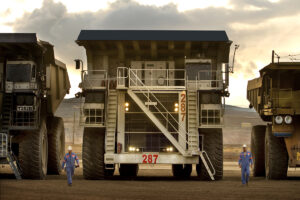Date: November 8, 2021
Author: Ken Kuchling
From time to time I come across interesting new tech that I like to share with colleagues. The topic of this blog relates to solving the problem of defining an optimal infill drill program.
In the past I have worked on some PEA’s whose economics were largely based on Inferred ore. The company wanted to advance to the Pre-Feasibility (PFS) stage. However, before the PFS could start they would need additional drilling to convert much of the Inferred resource into Measured and Indicated resources.
I’ve seen similar experience with projects that are advance from PFS to FS where management has a requirement that the ore mined during the payback period consist of Measured classification.
The Problem
In both cases described above, it is necessary for someone to outline an infill drill program to upgrade the resource classification while also meeting other project priorities. The goal is to design an infill drill program with minimal time and cost yet maximize resource conversion. Possibly some resource expansion drilling, metallurgical sampling, and geotechnical investigations may be required at the same time.
I’m not certain how various resource geologists go about designing an infill drill plan. However, I have seen instances where dummy holes were inserted into the block model and then the classification algorithm was re-run to determine the new block model tonnage classification. If it didn’t meet the corporate objectives, then the dummy holes may be moved or new ones added, and the process repeated.
One would not consider such a trial & error solution as optimal. It may not necessarily meet the cost and time objectives although it may meet the resource conversion goals.
The Solution
The DRX Drill Hole and Reporting algorithm developed by Objectivity.ca uses artificial intelligence to optimize the infill drilling layout. It intends to match the QP/CP constraints with corporate/project objectives.
For example, does company management require 70% of the resource in M&I classifications or do they require 90% in M&I? Each goal can be achieved with a different drill plan.
The following description of DRX is based on discussions with the Objectivity staff as well as a review of some case studies. The company is willing to share these studies if you contact them.
The DRX algorithm relies on the resource classification criteria specified by the company QP. For example, the criteria could be something like “For a block to qualify as Measured, the average distance to the nearest three drill holes must be 30 m or less of the block centroid. For a block to qualify as Indicated, the average distance from the block centroid to the nearest three holes must be 50 m or less. For a block to qualify as Inferred it will generally be within 100 m laterally and 50 m vertically of a single drill hole.”
The DRX algorithm will use these criteria to optimize drill hole placement three dimensionally to deliver the biggest bang for the buck. Whatever the corporate objective, DRX will attempt to find an optimal layout to achieve it. The idea being that fewer well targeted holes may deliver a better value than a large manually developed drill program.
The DRX outcome will prioritize the hole drilling sequence in case the drill program gets cut short due to poor weather, lack of funding, or the arrival of the PDAC news cycle.
The DRX approach can also be used to optimally site metallurgical holes and/or geotechnical holes in combination with resource drilling if there are defined criteria that must be met (by location, ore type, rock type, etc.). The algorithm will rely on rules and search criteria developed by experts in those disciplines. It does not develop the rules, it only applies them.
DRX can also help optimize step-out drilling, such that the step-out distance will not be beyond the range that negates the use of the hole in a resource estimate. It can also consider geological structure in defining drill targets.
By optimizing the number of drill holes and their orientation, the company may see savings in drill pad prep, drilling costs, field support costs, and sample assaying.
One can even request drilling multiple holes from the same drill pad to minimize drill relocation costs and safety issues in difficult terrain.
A large benefit of DRX is to be able to examine what-ifs. For example, one may desire 85% of the resource to be M&I. However, if one is willing to accept 80%, then one may be able to save multiple holes and associated costs. Perhaps with the addition of just a few extra holes one could get to 90% M&I. These are optimizations that can be evaluated with DRX.
An Example
In the one case study provided to me, a $758,000 manually developed drill program would convert 96.6% of the Inferred resource to Indicated. DMX suggested that they could achieve 96.7% for $465,000. Alternatively they could achieve 94% conversion for $210,000. These are large reductions in drilling cost for small reductions in conversion rate. This may allow the drill-metres saved to be used for other purposes.
For that same project, a subsequent study was done to convert Indicated to Measured in a starter pit area. DRX concluded that a 5000-metre program could convert 62% of Indicated into Measured. A 12,000-metre program would convert 86%, A 16,000-metre program would achieve 92%.
So now company management can make an informed decision on either how much money they wish to spend or how much Measure Resource they want to have.
Conclusion
Although I have not yet worked with DRX, I can see the value in it. I look forward to one day applying it on a project I’m involved with to develop a better understanding of what goes in and what comes out. DRX hopes to become to resource drilling what Whittle has become to pit design – an industry standard.
The use of the DRX algorithm may help mitigate situations where, moving from a PEA to PFS, one finds that the infill program did not deliver as hoped on the resource conversion. Unfortunately, this leaves the PFS with less mineable ore than anticipated and sub-optimal economics.
New tech is continually being developed in the mining industry. Hopefully this is one we continue to see forward advancement. It makes sense to me and DRX could be another tool in the geologist toolbox. Check out their website at objectivity.ca
Note: You can sign up for the KJK mailing list to get notified when new blogs are posted. Follow me on Twitter at @KJKLtd for updates.
Posted in: Junior Mining, Mine Modelling, Mine Studies.Tagged: 43-101, exploration, Feasibility Study.Last Modified: November 8, 2021
Ken Kuchling
Source link



